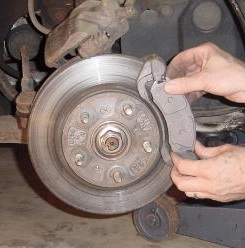When I was a young lass, my DIY father (in Detroit, blue-collar folks fixed, installed, maintained, and repaired everything themselves) relied on me to hand him the screwdriver, fetch rags, or jack up the car. He taught me house and car maintenance and repair. I grew up knowing the difference between standard and metric sockets and changing my own oil and brake pads.
Fast-forward 20... 30... 40... years. I no longer work on cars, but I help Pope with repairs to the house and boat. He relies on my superior powers of observation to see what he missed, find things that roll out of his reach, and strategize how to clean mold out of a hose or run an electrical line.
Last month, I branched out and helped my professional carpenter friend, Dana S., build an outdoor gate. I still had the knack for handyman's assistant--holding a board to be sawed, drilling holes, screwing on panels.
This week, I tucked into the boat for a leisurely sail with Pope, carrying out routine First Mate duties: taking the helm, dropping anchor, scrubbing and provisioning. Suddenly, an urgent call proffered a detour--and a chance to add a project to my fix-it portfolio.
When the SOS came over the airwaves from our new sailor friend Roland F., Pope and I looked at each other and nodded. Within minutes, we raised the spinnaker and high-tailed it under the Bay Bridge for Rock Hall, on the far side of the Chesapeake.
Roland lives aboard a 34-feet cutter, Kodachrome. After a year restoring the boat, his toolkit has grown to include heavy-duty drills, grinders, trowels, varnish, electrical supplies, and a sewing machine. Clearly, he knows boat systems and repairs.
But he forgot one small detail. He didn't tie a stopper knot at the end of his main halyard.
A halyard attaches to the top of a sail to pull it to the top of the mast. The line travels down inside the mast to the deck, then back to the cockpit, where a crew member can pull it to raise the sail.
The cockpit end normally passes through some type of jammer, which stops the line from being accidentally pulled up through the mast (and accidentally dropping the sail). The knot on the end is a backup.
A few days ago, Tropical Storm Philippe sent shock waves up the east coast, boasting winds of 40-50 mph. At Rock Hall, the winds clocked in at 55 mph. Scrambling to secure a hundred items on his deck, Roland--alas--overlooked the absentee knot. The violent wind lifted his main halyard, jerking it out of the jammer and clean out of the mast. More than 45 feet of line, whipping and cracking out over the water! (Secured only at one end. Ahem.)
It took two days for us to get Kodachrome's mainsail back into action. Roland ascended twice to drop a leader line, then the wayward halyard, 45 feet down through the inside of the mast, and to complete ancillary repairs at the top.
Pope handled the raising and lowering of tools, drilling new parts, untangling lines, and tying knots. (I'm no good at knots.)
The fellas relied on me to finesse the fine details--probing the inside of the mast through a 1/2-inch hole at the bottom, clearing obstacles and searching for the leader line and later the halyard.
Success! Out came the safely restored line from the bottom of the mast.
A valiant effort by three fixer-uppers prevented this skipper from having to spend hundreds of dollars at a boatyard to dismantle the mast.
Nothing left to do but return to Echo II to fix one more thing--a dark 'n' stormy, my favorite drink--on the deck at sunset. And to tie stopper knots at the ends of all our lines. Isn't that, ultimately, what handyman's assistants are for?















Perfect book chapter, Amber.
ReplyDelete